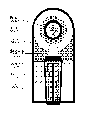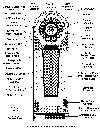



By Richard K. Brown
Comments on this page were revised by Carey Sublette.
The designs appearing on this page were prepared in GIF form by Richard Brown. They are a mixture of reasonable illustrations of design principles, and speculative designs of either highly hypothetical weapon concepts or of actual weapons.
As noted below, most of these illustrations and much of the text here are taken from Weapons of Tomorrow by Brian Beckett (Plenum Press, 1983). In particular, the Fusion Boosted Fission Weapon, the Fission-Free Neutron Bomb, and the Bi-Conical Mini-Nuke illustrations (and the text that accompanied them) can be found there. I have added my own remarks about the designs. In some cases, where I felt that Beckett's text was unhelpful or misleading, I have replaced it with my own remarks. --- Carey Sublette, November 1996
 Implosion Device (revised: 1 May 1995)
Implosion Device (revised: 1 May 1995)
In the center is the 'pit' with the neutron source (fission initiator) which usually consists of tritium
gas.
This is also the primary device in a fission-fusion-fission thermonuclear device.
 The Teller-Ulam Configuration (revised: 1 May 1995)
The Teller-Ulam Configuration (revised: 1 May 1995)
Thermal radiation in the form of soft X-rays are released by the fission primary (trigger). The photon gas fills the bomb casing, and produces tremendous pressure that implodes the secondary stage to very high densities. When the implosion shock reaches the center of the secondary, the fission spark plug is compressed. The energy released by the spark plug ignites the fusion reaction, leading to the main energy release in the weapon.
 Fusion Boosted Fission Weapon (revised: 1 May 1995)
Fusion Boosted Fission Weapon (revised: 1 May 1995)
In this levitated pit design, the thin outer shell of plutonium is driven inward by the explosive charge at
velocities of several kilometers per second. The impact of this shell on the center sphere of plutonium
creates two very high pressure shock waves, one travelling in toward the center and one travelling out
through the shell. These shocks, with pressures of several megabars (several million atmospheres)
compress the plutonium to densities of 2.5-4 times normal. The collapse of the central sphere also
compresses the fusion fuel in the center.
When the fission reaction has released enough energy to raise the temperature in the core to several
million degrees K (a few hundred tonnes of TNT equivalent), a fusion reaction is ignited in the fuel. The
deuterium + tritium fusion reaction:
D + T -> He-4 + n + 17.6 MeV
produces large amounts of extremely high energy neutrons (14.1 MeV). When one of these neutrons
collides with a plutonium nucleus, it fissions and releases an additional 4.5 neutrons on average
(compared to about 2.9 for fission induced by lower energy fission neutrons). Since each fusion neutron
directly generates 180 MeV through fission, and another 810 MeV as a result of the second generation
neutrons, the energy released by fusion driven fission greatly exceeds that produced by the fusion reaction
itself.
The following two designs are speculative design concepts that are not known to have been actually demonstrated in any test.
 Fission-Free Neutron Bomb (revised: 1 May 1995)
Fission-Free Neutron Bomb (revised: 1 May 1995)
From _Weapons of Tomorrow_ by Brian Beckett: " In a fission-free Neutron bomb an efficient driver would generate enough fusion energy to cause the explosive shock wave to compress the core to hyper-densities of 10,000 times the norm. The liner, a heavy metal of variable density would profile the shock wave for maximum compression. Because of size considerations, yields would probably be limited to a kiloton or less and, in such things as artillery shells, the device would be a cylinder rather than a sphere. This would be less efficient but, with high compression, the weapon would still be highly effective. The details illustrate the idea for an enhanced radiation neutron device. The core might release around 900 tons of TNT equivalent with up to another 100 tons coming from the surrounding shell. An example of a suitable liner might be a copper-beryllium alloy and the driver would be made of a dense metal such as iridium. "
Comments by Carey Sublette:
This is a speculative design for producing fusion reactions without using fissile material to provide the
ignition heat. The idea is to use the energy concentrating effects of an implosion to create fusion
conditions by compressing and heating fusion fuel at the center. This design combines the several
techniques, explosive driven flying plates, shock profiling from collisions with shock buffers, and the
convergence effect of thick collapsing shells, and spherical implosion waves.
In principal, a highly symmetric implosion system could produce fusion conditions in a very small central
region. Sonoluminescence - the observation that small bubbles oscillating in a sound field can be made to
glow brightly in the laboratory, apparently through heating to incandescence - is an example of how
temperatures far in excess of ambient conditions can be created by spherical wave convergence.
It does not appear, however, that significant releases of fusion energy have ever actually been produced by
such systems, much less been developed into usable weapons. Given the very low energy density in
conventional high explosives compared to fissile material, such a system (even if feasible) is certain to be
far larger and heavier than fission driven neutron bombs. Since the principal cost factor in a neutron
bomb is the very expensive tritium used as a fusion fuel, it is doubtful any cost advantage would exist
either.
 Bi-Conical Mini-Nuke (revised: 1 May 1995)
Bi-Conical Mini-Nuke (revised: 1 May 1995)
From _Weapons of Tomorrow_ by Brian Beckett:
"The bi-conical system is said to be capable of compressing uranium or plutonium by values of five to
seven and reducing critical mass to between 54 and 100 gm. The fission cores of such bombs would have
diameters of only 2.68 to 3.38 cm (1.05 to 1.33in) but still be capable of one or two kiloton yields. Very
efficient weapons using fusion enhancing reflectors might enable reliable yields of up to four or five
kilotons (Major reference: S. Kaliski, Journal of Technical Physics, Warsaw, Vol. 19, 4, 1968)."
Comment by Carey Sublette:
This shock wave amplification system relies on the Mach effect created by colliding shock waves. Work
published by the Soviet researcher Alt'shuler describes achieving pressures of several megabars using this
system (shock pressures in the same range as conventional implosion systems). The claimed performance
of this system appears physically impossible. The five to seven fold compression factors claimed take us
into the regime of Fermi degenerate matter, requiring pressures far in excess of those described in the
literature. From fundamental physical principles alone it is obvious that the energy required to achieve
this degree of compression in the masses mentioned implies very large amounts of high explosives, even if
the energy could be efficiently concentrated and applied to achieve the extreme pressures needed.
 The B28 Bomb (revised: 1 May 1995)
The B28 Bomb (revised: 1 May 1995)
This is a more detailed illustration of the Teller-Ulam configuration as used in the B28 bomb. This example was picked because at one time it represented the backbone of US nuclear weaponry. Also, for what ever the reason, more information seems to be available on this type than most other modern nuclear weapons.
For a nicely executed color solid-modeled version of this conceptual design, by Paul McDonell, click here for an internal view (110 K), or here for an external view (48 K).
Comment by Carey Sublette:
This is a speculative diagram of the design for the B-28 prepared by Richard Brown. According to Brown
this diagram depicts the features he believes the B-28 to have based on open literature reading. Since the
actual design of the B-28 is not available in the open literature, this diagram can only be considered a
speculation that illustrates of how it might be internally arranged. Overall this design seems reasonable,
though specific features may be open to question. The color JPEGs by Paul McDonell, being derived from Brown's diagrams, are no more accurate than Brown's despite their much greater sense of three dimensional realism .